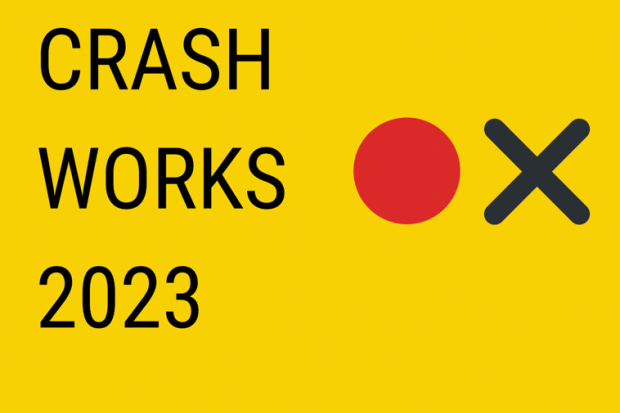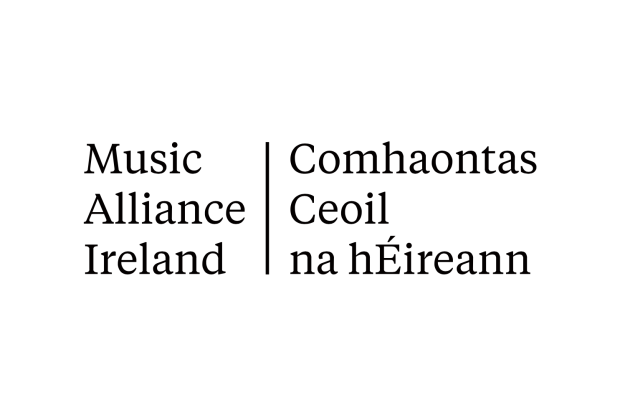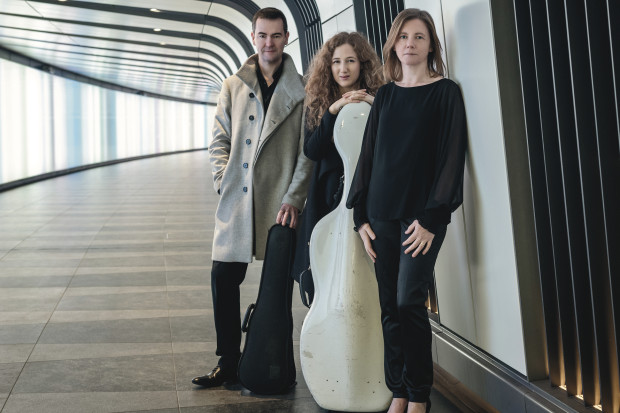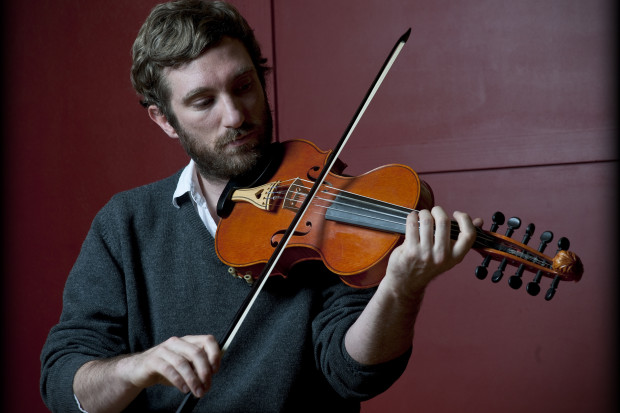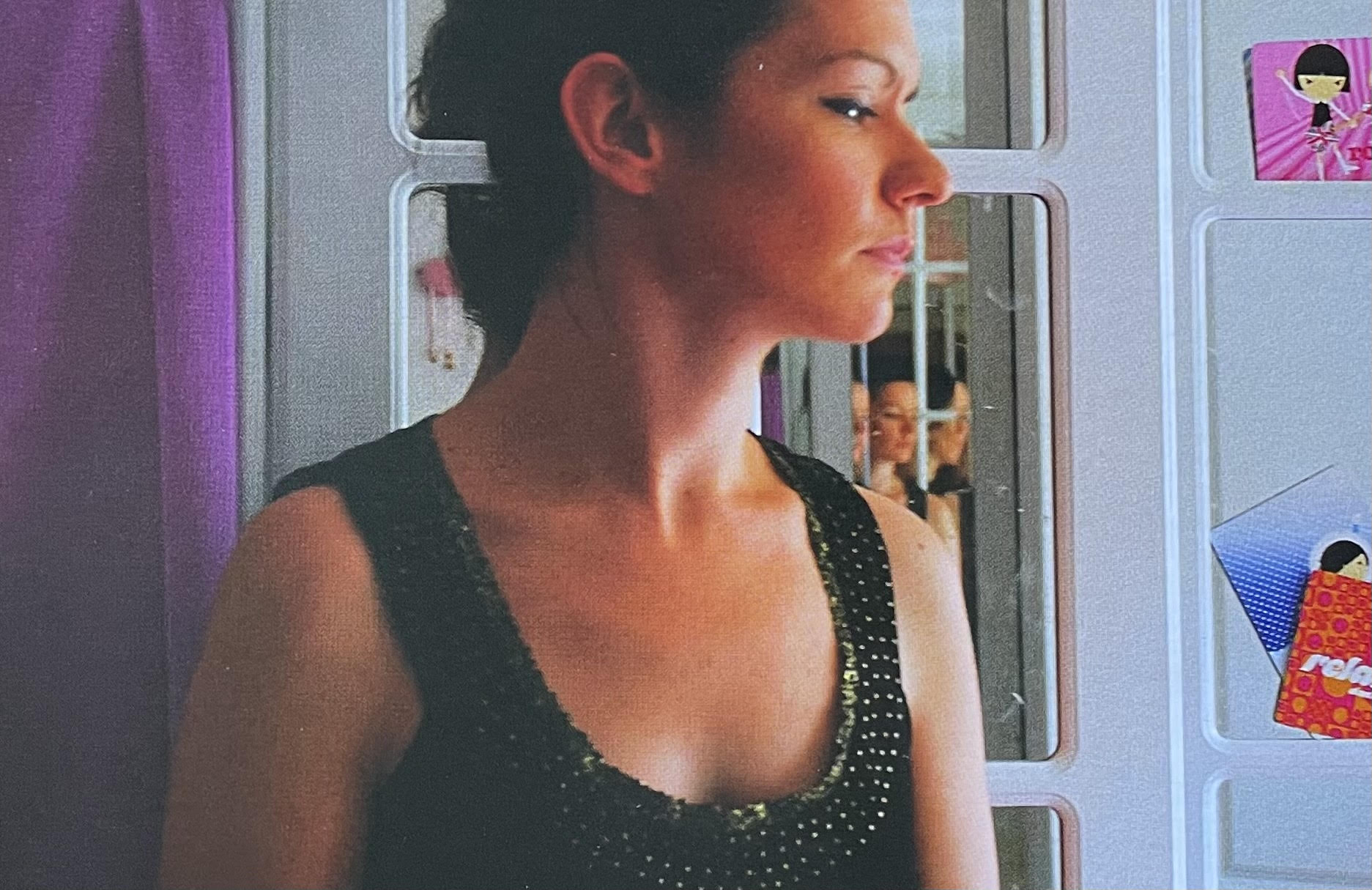
Linda Buckley (Photo: Lucy Clarke)
All Collisions End in Static: the Music of Linda Buckley
I had a dream once in which I found myself locked overnight in a Gothic cathedral and was banging frantically on the heavy wooden doors in an attempt to make myself heard so someone would let me out. A few last votive candles had been left unextinguished by the entrance. In the flickering light I watched with horror as ghostly choirboys processed up the nave, singing. As their voices filled the air they were joined by other invisible sounds, incorporeal voices trapped in the roof spaces. I looked up and saw that these ‘voices’ were colours, pulsating clouds of pale pink, scarlet, burnt orange. As the music continued I was given to understand that a voice, once lifted in praise, never stops sounding through all eternity: its singing is continuous and its echo only need be reactivated by the voices of the living.
If ever someone were to make a film of this dream I know the perfect soundtrack for it: Libera Me, for voices, organ and electronics, composed in 2002 by a then Masters student in Music and Media Technologies at Trinity College Dublin, Linda Buckley.
Libera Me, its composer says, is based on the interplay of its three elements, chorus, organ and electronics. Sometimes the electronics behave like an aural shadow of the acoustic elements, like a ghost choir; at other times they move to the foreground, becoming the dominant force. The music (written for Dublin’s St Patrick’s Cathedral) explores the nature of an echoey acoustic environment by playing with reverberation times, and by seeing what happens to sound in the space – the use of four-channel diffusion allows Buckley to lay down paths for the sounds, which trace trajectories in the air as they decay. The interplay of human and non-human sources unleashes all manner of psychoacoustic effects in the listener’s ear. The cathedral itself helps shape the textures of the music, which are sometimes dense, sometimes spectrally empty. Especially striking are the unison downward glissandi in the voices; because it is impossible to synchronise these glissandi precisely, the effect is complex, like watching in slow motion a bucket of nails being emptied out of a tenth-floor window. Equally unsettling is the scurrying, convulsive passagework from the organ and its massive tone clusters that billow down the aisles towards us.
Libera Me was an important work for Buckley, partly because it was the final piece in her Masters portfolio, and partly because it was the piece in which she was finally able to express everything she wanted to say in a single work. The Latin text (‘Deliver me, O Lord, from eternal death’), from the Requiem Mass, is heavy stuff – she wanted to write an entire Requiem but was ‘wisely’ talked out of it by her tutor – and such electrifying, death-obsessed music is not quite what one might expect from the cheerful, enthusiastic young woman that wrote it. Perhaps a scary Goth lurks beneath her glamorous exterior.
This, however, is only one dimension of Buckley’s sound world. When she returned to the medium of voices with electronics this past autumn in a new work, Fall Approaches [haustid nalgast], written for New Dublin Voices and first heard at a Spatial Music Collective concert in Trinity College Chapel in January 2008, the music she produced could hardly have been more different. Fall Approaches is highly serene music filled with deep undercurrents of emotion, which well up and seem several times on the point of flooding out. The vocal harmonies are entirely built from the notes of the C major scale, but for the most part without conventional tonal voicings; this makes the sound at once familiar and slightly strange, the strangeness intensified by the eight-channel tape part, which adds subtle ring modulation to the vocal timbre as well as providing brittle, ‘glitchy’ fragments of melody and low bass pulsations. The text, by the turn-of-the-last-century Icelandic poet Stefán frá Hvitadal, looks to the coming cold season and the loss of the sun, which will remain for weeks below the horizon, yet takes consolation in the protection of the stars – ‘a light watching over us, hope emerging from the darkness’. The music is intensely beautiful, almost tearfully so. ‘A strange thing about that piece was that I could only work on it when it got dark’, Buckley tells me. ‘I wrote it between October and November [2007] and if I ever wanted to start work on it in the morning it was almost as if the piece led me, saying “let’s wait until darkness falls!” – so I could only ever really get absorbed in it after about 5pm’. Fall Approaches has a sound world characteristic of her, combining pure vocal tones and electronic noise: ‘beauty with a rough edge’.
This tendency to push her way to the extremes, as though to find out where they are, is characteristic of Buckley’s music and of her personality in general. ‘I’m often drawn to extremes’, she tells me, ‘drone/static textures and also hyperactivity… maybe this relates to how I am as a person, very open, very emotive, excited. I push myself to the limits and never want to waste a second, but then also need stillness and calm. I’m drawn to these things in music also’. I’m thinking she means someone like Phill Niblock or Eliane Radigue (for the drone/static textures) and Brian Ferneyhough or Richard Barrett (for the hyperactivity), but the example she actually gives is from Icelandic post-rockers Sigur Rós – the tenth track, ‘Svo hljótt’, from their album Takk…, which she admires because it ranges all the way ‘from lush drones to huge climaxes’ in a single piece. Among her own works, the one that best symbolises this meeting of opposites is all collisions end in a static, a 2003 composition for flute, viola, harp and tape co-composed with Keith O’Brien. The programme note for that piece she now finds quite prophetic, describing as it does a situation where ‘bursts of energy eventually exhaust themselves in a state of enlightened torpor.’ This is a recurring concern in her music (‘also kinda like my life’). Static is the result of too much electrical charge, for example when two objects collide and exchange electrons; a lot of her pieces seem to be related to exploring exchanges of energy, two different things coming together and generating a new condition out of their collision
A Love of Music Could Override All That
She grew up on a farm on the wild, untamed cliff-side setting of the Old Head of Kinsale in County Cork, ‘right on the edge of the world facing the power of the Atlantic Ocean.’ She remembers as a young child ‘listening to the sound of the foghorn from a nearby lighthouse… very, very haunting and quite eerie but beautiful as well. Also, I was always fascinated with the sounds of the milking machines on the farm. They have a mechanical rhythmic metallic quality and I think that they informed my compositional thinking later on in some ways’. She is the youngest of nine children, ‘so it was quite a crazy, chaotic household, but very exciting because most of us learnt instruments at some stage – anything from piano to cello to accordion’. Her sister Irene has become a composer, her sister Annette a singer/songwriter, and her sister Catherine a music teacher. Their father comes from a traditional music background and plays accordion and sings; and Buckley says her mother ‘also had a major influence on me, partly to do with her unusual style of singing. When I was a very young child she used to sing me these rather atonal nursery rhymes and I remember thinking that they were very beautiful. These were my earliest melodic memories’. Her instinct to compose first showed itself when she would deviate from her piano practising routine and spend more time messing around than perfecting her scales. She began putting notes down on paper at secondary school, a mixed-gender convent school. There she had a wonderful teacher, but otherwise the facilities were not good – her music lessons took place in a cold and dark room with an out-of-tune piano. But she learned that ‘a love of music could override all that’.
Linda Buckley is representative of a new general of Irish composers that has grown up with a hands-on familiarity with a wide cross-section of the world’s musics. If her school years were dominated by Irish traditional music and Western classical music, as an undergraduate at University College Cork she found herself in an environment that offered encounters with many musical traditions worldwide, not simply with the achievements of dead white European males. ‘I studied ethnomusicology with Mel Mercier so I was actively performing things like south Indian vocal percussion, Javanese Gamelan and African drumming. I also studied sean-nós singing. I studied composition with John Godfrey. Also, medieval music was a major influence for me at the time and still is. A very natural experience for me would be to go into college and have a sean-nós lesson, perform in the Javanese Gamelan ensemble and then study music of the thirteenth century, such as Pérotin. Kyle Gann talks about the idea of totalism and the totality of music expression and experience. That’s something that’s very important for me as well.’
I ask if she ever felt there was too much diversity, too many possibilities being thrown at her too early on, making it more difficult to find her identity as a young composer. She says no: ‘I assimilated them and I filtered them through my own experience and I think they came out in my music, in various subconscious ways also. I think the range of different musics was hugely important for me and I never really felt that I had to choose between them. I always found very strong connections between them. I never felt I needed to build boundaries; they all felt natural.’
In My Mind
One of the things that grounded her in the face of all this thrilling musical diversity was an involvement with electronic music. She produced her first electroacoustic composition, Androgyny, at the age of eighteen, as a result of studying at the Ennis Composition Summer School with Michael Alcorn. ‘Earlier on when I had experimented with composing for piano I always felt that it was quite limiting, it wasn’t really expressing the sounds that were in my mind. Michael taught me the program Csound, and I remember being very excited about the possibilities. Suddenly I felt that I could recreate these sounds that I hear in my mind very clearly’. The piece was written for violinist Darragh Morgan, using samples of violin sound and some fairly straightforward processing. Through it, she developed a sense of being able to experiment with sound, an attitude that has remained with her ever since. She tells me that she feels a real connection to the world of electronica; many of her friends are involved in this form of music-making too, so there is a kind of community. She feels a kinship with her composer colleagues in Dublin’s Spatial Music Collective in that, with electronic music as a kind of given, there are nonetheless ‘many other strands of music going on in their lives; the different worlds we inhabit blur into each other’. She likes electronica artists like Squarepusher, Aphex Twin, Boards of Canada, Autechre. But the labyrinth of present-day software and hardware does not in any sense negate the appeal of acoustic instruments. ‘The electronic music experience in my life has definitely influenced my acoustic writing and vice versa’, she says. I think of acoustic instruments as sound-making devices in a way. Even my orchestration I almost think of as additive synthesis; you’re combining all these timbres to create a new timbre’.
In her 2004 composition Do you remember the Planets? (which can be heard on Contemporary Music from Ireland, Volume 6), for example – a musical meditation on Pythagoras’ belief in the ‘music of the spheres’ – the electronics are used as an extension of the acoustic sound of a solo viola. Much of the viola material was conceived first, and then transformed electronically to create an aural shadow; the piece is full of the rich, granulated, glitchy sounds that so appeal to her. At times the viola sound is subject to distortion, bringing out what she calls its ‘raw, aggressive’ characteristics which, typically, are played off against the pure, ethereal sounds of natural harmonics and their electronic transformations.
In the more recent Stratus for ensemble and electronics, commissioned for the Crash Ensemble in 2006, she tried a different approach: wanting to create a dense, complex texture, she analysed (with the help of the computer) a sample of a trombone glissando, and mapped its harmonic spectrum onto the parts for the live players. The pre-recorded part is based entirely on the trombone sample, and the live musicians play, as it were, the inner detail of that sound, as though they were viewing it through a microscope. The piece is one of her most fascinating, with throbbing low bass tones and instrumental colours high up in the acoustic spectrum. Her description of the piece in the programme note reads: ‘Low-level blankets of cloud, interwoven layers competing amongst the obscurata. Close up everything is without focus. The shape is perceived from afar’.
She has done several pieces for instruments and electronics together, and about half a dozen purely electroacoustic pieces, with intriguing titles – ill met, la lai de la concrète, Drowning in Colour, Stratus, Stop what’s started, Seek. They’re all good, with a confidence in handling the medium that makes all manner of sonic adventures possible. My personal favourite of these, once I recover from the heart-attack-inducing opening sonority which catches me out every time, is Stop what’s started, which began life in 2006 as a piece for saxophone, cello, double bass and playback, but which she reworked the following year for four-channel playback alone. This piece, she says, has much to do with her ‘other life’ away from Dublin: that in Berlin, where she often spends the vacation periods when she is not teaching at Trinity College. Stop what’s started ‘is definitely connected to staying out all night in Berlin and going to noise gigs in squats – quite underground, raw and visceral.’ She made it by means of a working process she sometimes uses, that of generating electronic material ‘very intuitively’ using the programming environment Max/MSP. ‘I sometimes have a “jam” in Max’, she says, ‘very much absorbed in the moment, and then later edit the results closely’. The piece is in two contrasting parts, the first noisy and industrial, like a consort of malfunctioning chainsaws that nonetheless prove to be surprisingly harmonious, and the second gentle and hypnotic, like distant organ music on the threshold between sleep and waking, giving way to a surprising, quasi-chaotic conclusion. And then there is Seek, her most recent purely electronic piece, which is all about ‘drowning in sound – like diving into a sea of lush microtones’. It was composed for presentation by the Spatial Music Collective and is based on a single violin line which is expanded with microtonal deviations throughout the speaker array. Some enterprising label ought to issue all her electronic pieces on CD – this is an exciting body of work that marks her out as a leading figure in the younger generation of Irish composers working in the medium.
There’s Someting Liberating and Anarchic About It
Buckley’s involvement with electronics can be heard in a different context in her work with the Berlin-based noise band die Oktoschlocks, of which she is a member, and with which she performs as often as time and circumstance permit. Die Oktoschlocks are everything a Berlin noise band should be, as you can hear in the examples on their MySpace site (but don’t be a wimp like me – turn it up). This is a scene populated by bands who have hundreds of metres of cable connecting their equipment, and who talk about things like ‘oi!core’, ‘teknoise’ and ‘dark listening’. The high decibel level is part of the language, but the music is only chaotic up to a point; I wonder to what extent the fact that all five members of die Oktoschlocks describe themselves as ‘composers’ is responsible for the high degree of coherence in their totally non-notated music. ‘It’s been great fun to play with die Oktoschlocks’, Buckley tells me – ‘there’s something liberating and anarchic about it. We played in Venice last year and caused a bit of a stir with our hardcore noise!’
While she loves the culture of Berlin, with its fascinating juxtaposition of symphony and squat, Buckley feels that now is an incredibly exciting time to be in Dublin. She is an active participant in the Dublin scene, and recent works have been commissioned by a great many Irish musicians and ensembles, including the Crash Ensemble, the Fidelio Trio, Natasha Lohan, Darragh Morgan and Mary Dullea, the Rothko String Trio, and others. It is difficult to know quite how her music will develop from her impressive achievements thus far. In works like Fall Approaches, and in even more recent pieces like Q for female voice and electronics and Fiol for string trio, all premiered this year, Buckley engages with an area of experience that new music is generally shy of, which, simplified and reduced to a single word, I’d call ecstasy. Not the drug-induced euphoria of dance music, but exultant, heightened states of being that are the product of an excitable sensibility, of an emotional response to the world that sees the bright places of life as clearly as the dark. A line from the text she set to music in Q (by the thirteenth- century Persian poet Jalal ad-Din Muhammad, known as Rumi) reads: ‘Become the sky./ Take an axe to the prison wall./ Escape./ Walk out like someone suddenly born into colour.’ The music, a gradual crescendo over twelve minutes, perfectly captures the poem’s uplifting description of rebirth through love. Take ten-second samples at random from Q and we might be listening to an unknown laptop artist in a squat; to an extract from a multi-million dollar pop album with rich, sensuous vocals (Björk? Goldfrapp? don’t ask me); or to a computer music demonstration in a university. In Linda Buckley’s world all these musics collide and end in static that is as delicious as it is energising.
Published on 1 September 2008
Bob Gilmore (1961–2015) was a musicologist, educator and keyboard player. Born in Carrickfergus, Northern Ireland, he studied at York University, Queen's University Belfast, and at the University of California. His books include Harry Partch: a biography (Yale University Press, 1998) and Ben Johnston: Maximum Clarity and other writings on music (University of Illinois Press, 2006), both of which were recipients of the Deems Taylor Award from ASCAP. He wrote extensively on the American experimental tradition, microtonal music and spectral music, including the work of such figures as James Tenney, Horațiu Rădulescu, Claude Vivier, and Frank Denyer. Bob Gilmore taught at Queens University, Belfast, Dartington College of Arts, Brunel University in London, and was a Research Fellow at the Orpheus Institute in Ghent. He was the founder, director and keyboard player of Trio Scordatura, an Amsterdam-based ensemble dedicated to the performance of microtonal music, and for the year 2014 was the Editor of Tempo, a quarterly journal of new music. His biography of French-Canadian composer Claude Vivier was published by University of Rochester Press in June 2014. Between 2005 and 2012, Bob Gilmore published several articles in The Journal of Music.












